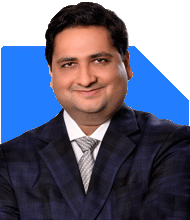Hardik Parikh | Answer |Ask -Follow
Tax, Mutual Fund Expert - Answered on Jul 23, 2023
He also holds an MBA degree from IIM-Indore.
Hardik, who began his career as an equity research analyst, founded his own advisory firm, Hardik Parikh Associates LLP, which provides a variety of financial services to clients.
He is committed to sharing his knowledge and helping others learn more about finance. He also speaks about valuation at different forums, such as study groups of the Western India Regional Council of Chartered Accountants.... more

Hellow Sir, In February, 2023 I had sold a House Property and there is Capital Gain around 15.00 lakh. From the sale proceed I received, I have already bought a housing plot(land) costing Rs.11.00 Lakh, in May, 2023, in a Govt. approved scheme and this has also been registered in my favour. All other formalities for its mutation has also been completed. Since I am planning to construct house on this newly acquired Plot in next 2 years, kindly guide:- (1)whether the amount already incurred in acquiring above Housing Plot would also be considered against utilization of Capital Gain ? (2)the amount I have to kept in the Capital Gain Account Scheme for utilization during construction of House shall be Rs.15.00 Lakh OR Rs.4.00 Lakh (after deducting cost of Plot i.e. Rs.11.00 Lakh) ? Kindly Guide Regards !
I understand your situation and I'm here to help. Based on the details you've provided and the current tax laws in India, here's what you need to know:
1) The amount you've spent on acquiring the housing plot can indeed be considered for the utilization of your capital gain. As per the Income Tax Act, if you reinvest the capital gains from the sale of a property in buying a new property or constructing a new house, you can claim tax exemption on the capital gains.
2) The amount you need to keep in the Capital Gain Account Scheme (CGAS) would be the remaining amount after deducting the cost of the plot from the capital gain. In your case, if you've already spent Rs. 11.00 Lakh on the plot, you would need to keep Rs. 4.00 Lakh (Rs. 15.00 Lakh - Rs. 11.00 Lakh) in the CGAS. This amount should be utilized for the construction of the house within the specified time period, which is 3 years from the date of sale of the original property.
You may like to see similar questions and answers below
Mihir Tanna |1090 Answers |Ask -Follow
Tax Expert - Answered on Jul 21, 2023
T S Khurana |538 Answers |Ask -Follow
Tax Expert - Answered on Nov 23, 2024
Ramalingam Kalirajan |10908 Answers |Ask -Follow
Mutual Funds, Financial Planning Expert - Answered on Dec 20, 2025
Ramalingam Kalirajan |10908 Answers |Ask -Follow
Mutual Funds, Financial Planning Expert - Answered on Dec 20, 2025
Naveenn Kummar |237 Answers |Ask -Follow
Financial Planner, MF, Insurance Expert - Answered on Dec 20, 2025
Ramalingam Kalirajan |10908 Answers |Ask -Follow
Mutual Funds, Financial Planning Expert - Answered on Dec 19, 2025
Nayagam P P |10859 Answers |Ask -Follow
Career Counsellor - Answered on Dec 19, 2025
Ramalingam Kalirajan |10908 Answers |Ask -Follow
Mutual Funds, Financial Planning Expert - Answered on Dec 19, 2025
Ramalingam Kalirajan |10908 Answers |Ask -Follow
Mutual Funds, Financial Planning Expert - Answered on Dec 19, 2025
Ramalingam Kalirajan |10908 Answers |Ask -Follow
Mutual Funds, Financial Planning Expert - Answered on Dec 19, 2025
Radheshyam Zanwar |6751 Answers |Ask -Follow
MHT-CET, IIT-JEE, NEET-UG Expert - Answered on Dec 19, 2025
Radheshyam Zanwar |6751 Answers |Ask -Follow
MHT-CET, IIT-JEE, NEET-UG Expert - Answered on Dec 19, 2025

























